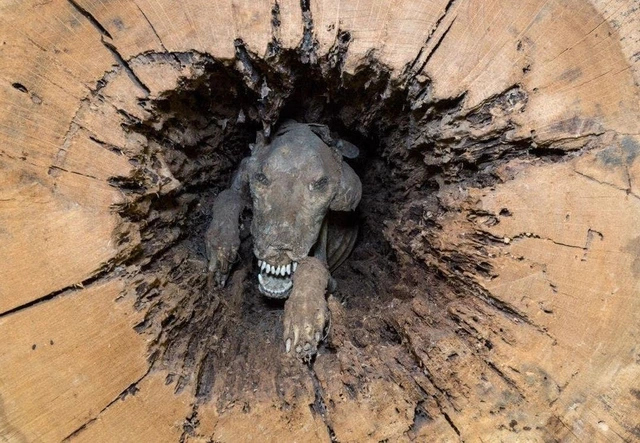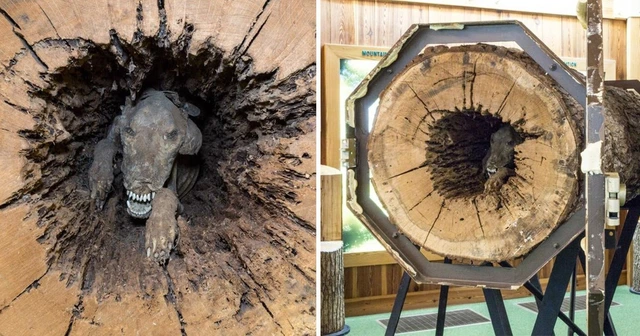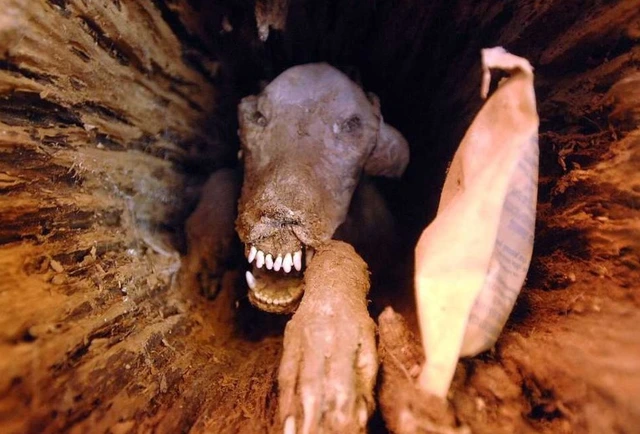NXT The Tragic Story of the Dog Who Chased Its Prey, Got Stuck Inside a Tree, and Became a Natural Mummy After 65 Years
Even today, Stuckie remains there — inside an oak log, surrounded by crowds of curious visitors. He stands as a silent witness to the bond between life and death, between humans, animals, and nature.
In the small town of Waycross, Georgia (USA), there’s a museum called Southern Forest World, home to hundreds of preserved forest species and wildlife from the American South. Despite its modest size, this museum became world-famous thanks to one unusual “resident”: Stuckie — a hunting dog who became trapped inside a hollow tree and was naturally mummified for over six decades.

When visitors arrive at Southern Forest World, almost everyone stops in front of the two-meter-tall oak log displayed upright in the middle of the hall. Inside, through a glass window, lies the reddish-brown body of a dog — stiff but still intact, as if frozen in his final breath.
On his back still hangs the faint trace of a small collar, a silent reminder that he once had an owner. Few can look at Stuckie without feeling a shiver, but once they learn his story, fear quickly turns into compassion and admiration.
According to museum researchers, Stuckie was a four-year-old coonhound, living in the 1960s. During one hunt — possibly chasing a raccoon — he crawled into the hollow trunk of a massive oak.
The inside of the tree was hollow, but as he climbed higher, the space grew tighter. Tragically, he became trapped more than eight meters above the ground and could no longer turn around.
Scratch marks on the wood show how desperately Stuckie tried to free himself. His front paws still appear to be reaching upward, and his open mouth reveals bared teeth — perhaps from his final, hopeless struggle.

The oak tree’s structure unintentionally turned into a natural coffin. Airflow through the trunk created a chimney effect, carrying away odors of decay and deterring scavengers.
What’s more, oak wood contains tannin, a compound that binds protein and prevents bacterial growth. Over time, these natural substances seeped into Stuckie’s body, drying and preserving him in remarkably lifelike condition.
For decades, Stuckie lay hidden inside the tree — safe from rain, sunlight, and animals. It wasn’t until 1980 that loggers working near the Georgia–Alabama border discovered the strange sight while cutting the tree into sections. Inside one log, they found the mummified dog, still wedged in place.
When the 9-meter oak was cut into four pieces for transport, the section containing Stuckie remained intact. Workers were astonished to find his perfectly preserved body only a few centimeters beneath the bark.

The news spread quickly across Haralson County and beyond. The remarkable log was sent to the Southern Forest World Museum, where Stuckie became its most famous “exhibit,” attracting tens of thousands of visitors every year.
Unlike other preserved animals treated with chemicals or taxidermy, Stuckie’s body was 100% naturally mummified — one of the rarest known cases among mammals. Experts confirmed that the environmental conditions were just right for this extraordinary preservation.
At first, visitors came out of morbid curiosity to see the “dog inside a tree.” But after reading about his story, many changed their view — seeing not horror, but loyalty and perseverance.
To them, Stuckie became a symbol of devotion and determination — a brave dog who risked everything in pursuit of his mission.
Over 20 people have claimed to be Stuckie’s former owner, but none could be verified. The true identity of the hunter who once called him a friend remains a mystery. Perhaps they spent years searching, never knowing their loyal companion was entombed in a tree all along.
Nearly half a century has passed since Stuckie was found, yet his story continues to move millions around the world. Standing before the oak log in the museum, visitors don’t just see a mummified dog — they see a touching tale of loyalty, resilience, and the mysterious beauty of nature’s preservation.


